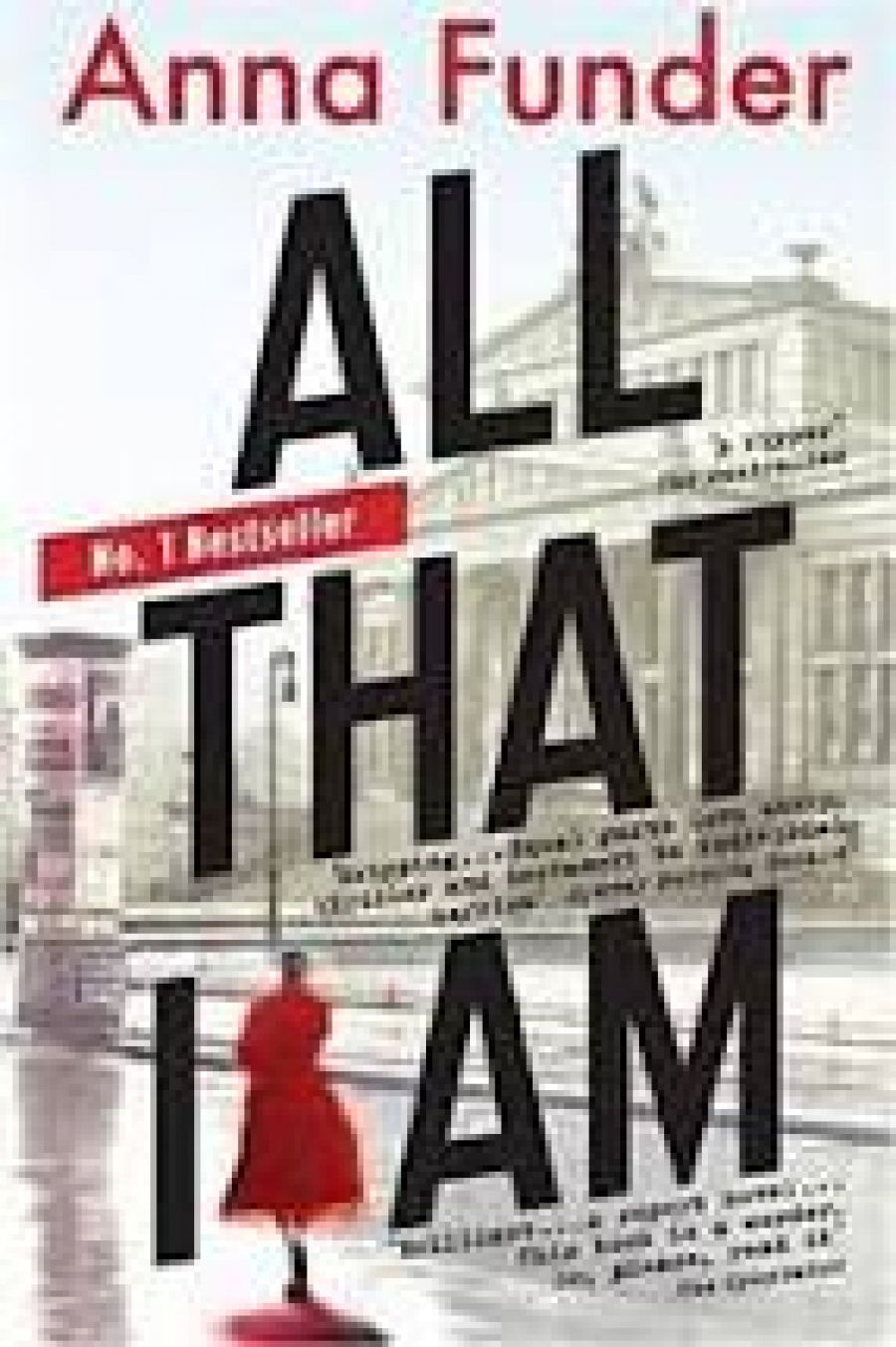
- Free Article: No
- Contents Category: Fiction
- Custom Article Title: Jo Case reviews 'All That I Am' by Anna Funder
- Review Article: Yes
- Online Only: No
- Custom Highlight Text:
The heroine of All That I Am reflects that an author’s published books ‘preserve the fossil imprint on the world of that particular soul at that particular time’. In her début novel – based on real characters and events – acclaimed non-fiction author Anna Funder (Stasiland, 2003) has preserved the imprint of a particular group of souls at a vitally important historical moment. A beautifully executed blend of historical fiction and psychological thriller, it follows the lives of a London-based network of activist refugees from Hitler’s Germany.
- Book 1 Title: All That I Am
- Book 1 Biblio: Hamish Hamilton, $29.95 pb, 384 pp, 9781926428338
Funder’s primary source was an oral history she recorded with Ruth Blatt, a German refugee she met and befriended while studying at the University of Melbourne. Years later, Funder decided to use Ruth’s story as material for a novel, incorporating some of the remarkable characters she was involved with. If you look, you will find information on the historical record about Ernst Toller, former socialist leader and renowned literary figure; activist and passionate feminist Dora Fabian (who smuggled his autobiographical writings out of Germany); Berthold Jacob, who fearlessly gathered information on Hitler’s preparations for war and relayed it through intermediaries to the world media; and journalist Hans Wesemann.
While Funder has taken pains to stay true to the essentials of how major events played out, she has transformed the base facts through the alchemy of fiction, creating a differently entwined cast of characters (for example, Ruth’s friend Dora is her cousin in the novel, with the shared childhood that entails), and fleshing them out with intricately invented details and psychology. This is not reconstituted ‘faction’ in the vein of Dave Eggers’s What is the What (2006), but a novel with its own unique identity.
The structure of All That I Am mirrors that of memory, which is not linear, but ‘snatches elements of story from whenever, tries to put them together’. Ruth and Toller take turns narrating, each of them separately trying to resurrect their adored Dora (Toller’s secretary, editor, and lover), who serves as the charismatic heroine of the novel. In a New York hotel room, Toller dictates revisions to his autobiography, writing the formerly absent Dora into the centre of it. Across the world and forward in time, in a Bondi flat, ninety-something-year-old Ruth reads Toller’s words, interspersing them with her own recollections.
In Stasiland, Funder exposed the workings of the East German surveillance state and its impact on ordinary lives – and the psychology of a nation already traumatised and divided by World War II. Central to the book was a steely determination to bear witness, to acknowledge what had happened and make a kind of sense of how and why.
All That I Am follows similar themes and impulses, illuminating the Germany that laid the foundations for Hitler’s Nazis to evolve and capture power, with the fevered embrace of many Germans. (The novel opens with Ruth, one of two narrators, taking a bath in her Berlin apartment while ‘waves of happy cheering, like a football match’ rise from the street on Hitler’s appointment as national leader.) Toller tells his New York secretary, ‘It is not possible to understand Hitler ... unless you understand his hatred. And that began with us.’ Funder traces Toller’s political history as a leader of the pacifist movement that informed Germany’s surrender during World War I, and of a short-lived, chaotic socialist government. There are hints as to how these events motivated Hitler in his determination to replace defeat and chaos with dominance and order, and why ordinary Germans similarly craved these things. One image of widespread uncertainty – ‘a brother and sister flying a kite papered with green scales ... the scales were money’ – is particularly resonant.
Funder’s observations of the gradual assertion of the Nazis’ grip on Germany ring cannily true, echoing those of Sebastian Haffner’s posthumously published memoir, Defying Hitler (written from London in 1939, published in 2000), in which he watches his peers being seduced by Nazism. All That I Am also evokes Christopher Isherwood’s classic Goodbye to Berlin (1939), with its bohemian characters, a crucial scene in a decadent nightclub with cocaine and live naked statues, and the socialists’ early assessment of Hitler’s Nazis as absurd, followed by a creeping realisation of their genuine threat.
‘Our lives would only have meaning if we could continue to help the underground in Germany and try to alert the rest of the world to Hitler’s plans for war,’ reflects Ruth of life in London. ‘But our English visas stipulated “no political activity of any kind”.’ As a result, they are stalked by Scotland Yard, which seeks evidence to deport them, and by the Gestapo, whose methods range from exposure (and arrest on deportation) to outright kidnapping and murder.
All That I Am forces us to face these uncomfortable historical truths: the stubborn complicity and dark consequences of world governments’ determination not to be confronted with what was happening, and the eerie fact that long before war was declared the Gestapo was hunting its enemies on foreign soil. It restores forgotten history in other ways, too. Funder resurrects the ‘memory of progressive Germany’ that Toller rightly predicted would be obliterated by the shadow of the Nazis. And she moves the stories of hugely influential women such as Dora Fabian from the footnotes of history to the main narrative, where they belong.


Comments powered by CComment